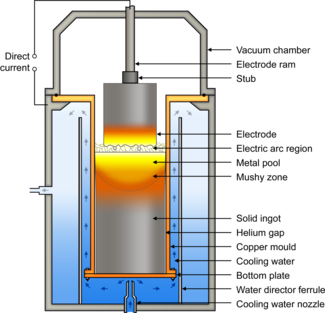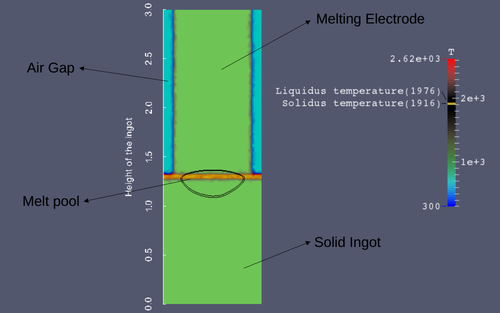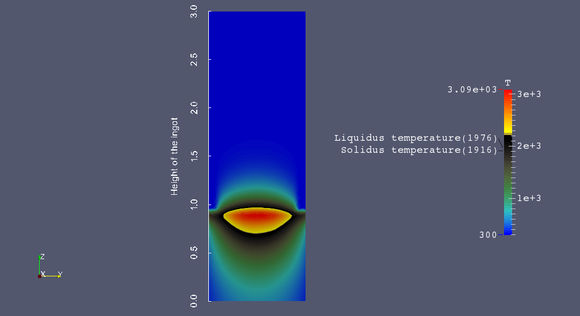Integrated Computational Materials Engineering (ICME)
Vacuum arc remelting – Process capabilities and Modeling approaches
Process description
Vacuum arc re-melting(VAR) is a process to obtain materials with high degree of homogeneity for applications in Aerospace, Aviation and Bio-Medical Engineering.[1][2] It differs from the traditional metallurgical techniques and is able to control the micro-structure more accurately. Typically the alloy to undergo VAR is formed into a cylindrical consumable electrode and is placed in a crucible which is at metallurgical vacuum (0.0010.1 mmHg or 0.113.3 Pa). A small amount of alloy to be remelted is placed at the bottom of the crucible. And the top electrode is brought in proximity to this material kept for remelting. Arcing between these two portions is brought about by passing several kiloamperes of DC current between the two pieces. The metal melts continuously and the top electrode is gradually moved downwards by a mechanical ram in such a way that the arc is maintained steadily between the electrodes. The arcing between the crucible and the electrode is controlled by designing the crucible to have a larger diameter than the electrode. The crucible is cooled with water jackets and solidification of the material is closely controlled. The quality of the resulting alloy is dependent on the cooling rate, gap between the electrodes and current.[3] Process parameter control is significant and can be directly linked to the material’s homogeneity and properties.[4] Nickel, titanium and special steels are often processed using VAR.

A visual depiction of VAR process
Process handling
Steady state melting and solidifications conditions are essential to maintain Bouyancy and Lorentz forces required to drive fluid flow in the metal pool ahead of the dendritic solidification front. The melting current and electrode velocity are the two handles available for the operator to maintain the process under steady state condition. The electrode gap must be small and constant. Intermediate and long electrode gaps can create a non-uniform current distribution on the anode or the pool surface and influence the fluid flow in the melt pool. The electrode gap is usually controlled by drop short frequency, anode spike frequency and furnace voltage. Under small electrode gap metal is transferred by formation and subsequent rupture of molten metal columns(drop shorts). These columns form a low resistance bridge between the cathode(electrode) and the anode(ingot) and the arc is extinguished temporarily which is observed as a voltage drop across the electrodes.[5] Transfer of metal during vacuum arc remelting causes a pattern on the voltage waveform called drop shot and the subsequent arc reignition creates an anode spike which are used to control the electrode gap around a nominal value. Electrode gap and arc voltage in turn affect the melt rate. Melt rate control is essential to obtain the desired microstructure and minimize the segregation related defects.
Modeling Approaches
To model the temperature distribution in the solidifying ingot and to calibrate the fluid flow in the melt pool conventional finite element codes are used. Approaches can vary from 2-D Finite element based solvers to 3-D Axisymmetric Finite element models.[6] Simple two equation based K- models can be used to consider turbulent mixing in the melt pool. Latent heat associated with melting and solidification is also taken into account in most cases by using ethalpy method.[7] Heat removal by water jackets is modeled by newton’s law of cooling. Dirichlet and Neumann based BCs are also frequently used to model temperature on the outer surface of the ingot. Mass and momentum is conserved to determine the radial and axial velocities. Effect of buoyancy and Lorentz forces are also introduced to account for velocity due to magnetic stirring. Steady state assumptions are not valid in the case of VAR modeling in general due to the complex nature of the process and the interplay between various process parameters. A transient heat transfer model is used based on this rational.[8] Cellular Automaton which is a stochastic model is often coupled with FE code to predict the grain structure at different position of the ingot, grain size and parameters related to columnar to equiaxed transition(CET).[9][10] Heterogeneous nucleation assumed to start randomly at predefined number of sites with predefined nuclei radii are described by a continious gaussian distribution. This coupling between meso and macro scales helps us to calibrate the dendrite tip velocity.

Proposed VAR model

Temperature distribution in VAR
References
- ↑ M. McLean. "High Performance Materials in Aerospace, chapter Nickel-based alloys: recent developments for the aero-gas turbine," pages 135-154. Springer Netherlands, 1995.
- ↑ A. Kermanpur, P. D. Lee, M. McLean, and S. Tin. "Integrated modeling for the manufacture of aerospace discs: Grain structure evolution." JOM, 56(3):72-78, 2004
- ↑ Zhi-jun Yang, Hong-chao Kou, Xiao-hua Zhao, Jin-shan Li, Rui Hu, Hui Chang, and Lian Zhou. "Effect of remelting current on molten pool profile of titanium alloy ingot during vacuum arc remelting process." Journal of Shanghai Jiaotong University (Science), 16(2):133-136, 2011
- ↑ Hafid El Mir, Alain Jardy, Jean-Pierre Bellot, Pierre Chapelle, David Lasalmonie, and Jean Senevat. Thermal behaviour of the consumable electrode in the vacuum arc remelting process. Journal of Materials Processing Technology, 210:564-572, 2010
- ↑ F. J. Zanner. "Vacuum consumable arc remelting electrode gap control strategies based on drop short properties." Metallurgical and Materials Transactions B, 12:721-728, December 1981.
- ↑ Kanchan M Kelkar, Suhas V Patankar, Alec Mitchell, Osamu Kanou, Nobuo Fukada, and Kenji Suzuki. "Computational modeling of the vacuum arc remelting (var) process used for the production of ingots of titanium alloys.," In 11th World Conference on Titanium (Ti-2007), pages 3-7, Kyoto, Japan, 2007
- ↑ V. R. Voller. "An implicit enthalpy solution for phase change problems:with application to a binary alloy solidification." Applied Mathematical Modelling, 1987.
- ↑ Nastac. "Modeling and Simulation of Microstructure Evolution in Solidifying Alloys." Kluwer Academic Publishers, 2004
- ↑ R. C. Atwood, P. D. Lee, R. S. Minisandram, and R. M. Forbes Jones. "Multiscale modelling of microstructure formation during vacuum arc remelting of titanium 6-4." Journal of Materials Science, 39(24):7193-7197, 2004.
- ↑ Kou Hongchao, Zhang Yingjuan, Li Pengfei, Zhong Hong, Hu Rui, Li Jinshan, Zhou Lian" Numerical Simulation of Titanium Alloy Ingot Solidification Structure during VAR Process Based on Three-Dimensional CAFE Method" Rare Metal Materials and Engineering, 2014, 43(7): 1537-1542
